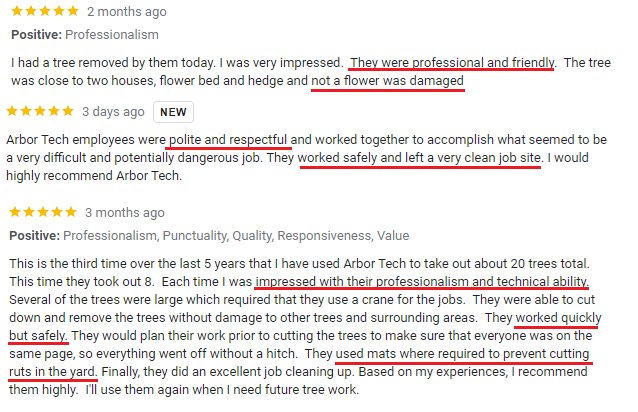Cracking the Code: 7 Elements of Google Reviews That Improve Your Local Ranking
Have you ever heard that your customers leaving a review on Google has no real impact on local search rankings and visibility?
Well, hold on to your screen because the truth is, these reviews pack a significant punch, and getting that coveted Google 5-star review should be a cornerstone in your local SEO strategy.
Now, before we dive into the nitty-gritty of how Google reviews affect local search rankings, let's dispel a big myth. Stuffing a bunch of keywords in owner responses to reviews won't make your business skyrocket through the rankings any faster. While it won't do much from an Local SEO ranking perspective, it does add a touch of finesse and acts as a reputation management element on Google, offering a know, like, and trust component for your small business.
So, what parts of a Google review can actually move the needle and improve your local ranking on Google? Let's break it down:
1. High Numerical Google Ratings (e.g., 4-5):
Ever heard the saying, "first impressions last"? Well, the same goes for online reviews. Higher numerical ratings build trust with potential customers and hold sway in Google's local search algorithm.
A business with a high numerical rating, say 4 or 5, indicates that customers are generally satisfied with the products, services, or overall experience provided by that business. Google considers these high ratings as a positive signal, and they can contribute to the business's credibility and trustworthiness in the eyes of potential customers.
In the realm of local SEO, search algorithms often take into account the average rating of a business when determining its local ranking. Therefore, businesses with consistently high numerical ratings are more likely to be favored in search results, as they are seen as providing a positive experience to customers. This is why maintaining a high average rating is considered one of the key elements for improving a business's local ranking on Google.

2. Quantity of Native Google Reviews (with text):
Numbers matter, but so does substance. Aim for a substantial number of reviews, especially those with detailed feedback. Reviews with text add depth to your online presence, offering valuable insights that resonate with potential clients.
The presence of text in reviews can offer more context and detailed information about the customer's experience, which is beneficial for both potential customers and search algorithms.

3. Recency of Reviews:
Keep the reviews flowing in. Regularly receiving new reviews signals to search engines that your business is actively engaged with customers. It's like telling Google, "Hey, we're here, and we're consistently making our customers happy!"
Recent reviews signal to search engines that a business is actively engaged with its customers. A steady stream of recent reviews indicates that the business is current and continues to provide products or services. This is why search algorithms favor businesses with recent reviews when determining local rankings — an active and engaged business is likely to be more relevant to current users.

4. Keywords in Native Google Reviews:
It's not just about the stars; it's about the words too. Relevant keywords in reviews can give your business an edge in local search rankings. Encourage your customers to express themselves naturally, weaving in those important keywords.
When users search for products or services related to your business, search engines analyze the content of reviews to determine relevance. If the reviews contain keywords that match the user's search query, it signals to the search engine that your business is relevant to those specific terms.

5. Positive Sentiment in Review Text:
Positive vibes matter. Positive sentiment in reviews not only attracts potential customers but also paints your business in a glowing light. Harness the psychological impact of positive reviews to win over new clients.
Search algorithms perform sentiment analysis on the text within reviews. Positive sentiments contribute to a business's positive online reputation, which, in turn, can positively impact its local ranking.

6. Quantity of Native Google Ratings (no text):
Even brief is better than nothing. Numerical ratings, even without accompanying text, play a role in enhancing your local rankings. The more ratings, the merrier!
The sheer number of ratings, even if they lack detailed comments, provides a clear indication of customer engagement with the business. A higher volume of ratings not only reflects popularity but also suggests the business is well-established and widely recognized.
This volume of ratings plays a pivotal role in how search algorithms assess the overall standing of a business. When determining local rankings, search algorithms consider the business's overall rating. Interestingly, even when reviews lack accompanying text, the numerical scores significantly contribute to the average rating.
This average rating is a crucial factor in local SEO, influencing the visibility and positioning of the business in search results. Therefore, the quantity of ratings, irrespective of the presence of text, holds substantial weight in shaping a business's online reputation and search engine ranking.

7. Quantity of Positive Google Review Attributes:
Specifics matter. Positive attributes mentioned in reviews contribute to your business's credibility. Encourage your customers to share detailed feedback on what they loved about their experience with your brand.
Ratings-only reviews pose several challenges. Firstly, they offer no meaningful information beyond the star ratings, providing neither Google nor the businesses being reviewed with valuable insights. Moreover, as Google accumulates numerous reviews, ratings-only entries contribute to a clustering effect, where results fall within a narrow range, hindering a comprehensive understanding of a business.
In response to this challenge, Google introduced review attributes. This tool prompts reviewers to click on specific words such as "professionalism," "responsiveness," or "timeliness" to serve as proxies for written reviews. The attributes are tailored to different categories; for instance, attributes valued in salons might include "cleanliness," while categories like insurance agents may emphasize "responsiveness."

Wrap Up
In conclusion, the elements mentioned above can work wonders for your business's local ranking on Google. Keep those positive reviews coming, respond thoughtfully, and maintain a stellar online reputation. After all, in the world of local SEO, your customers' voices are your strongest allies.




